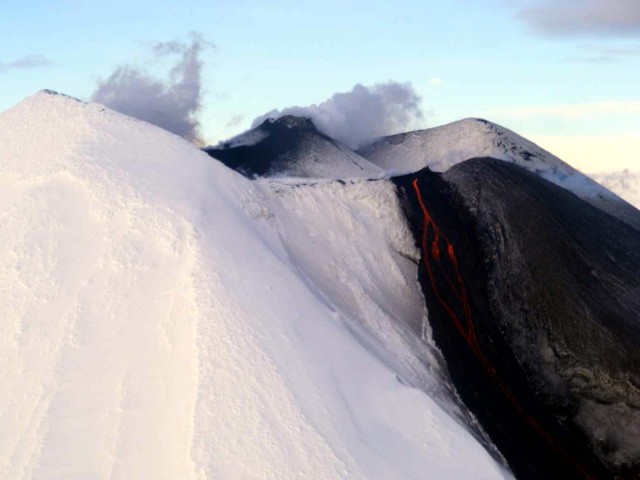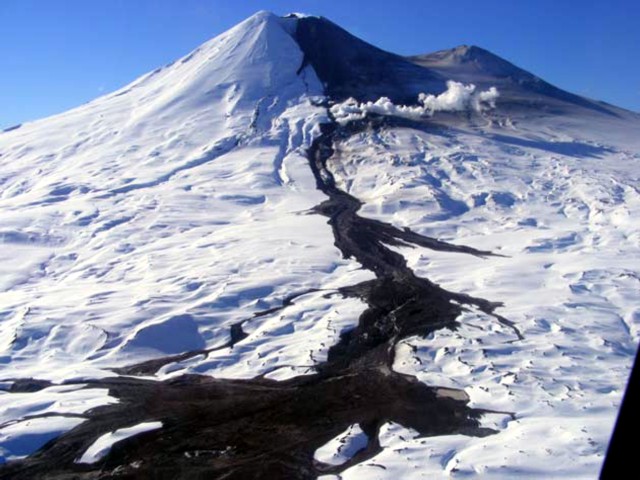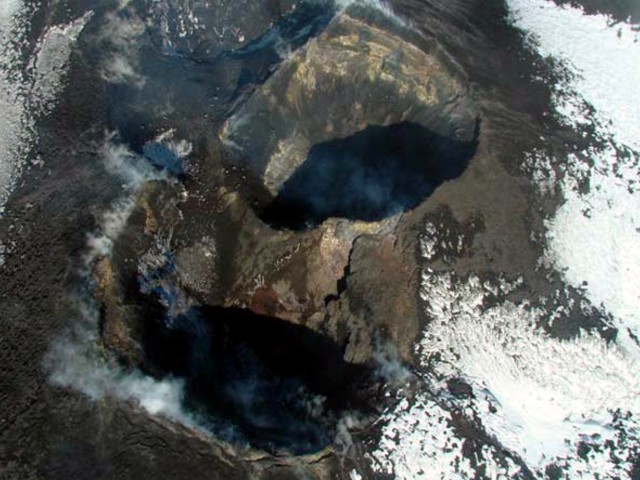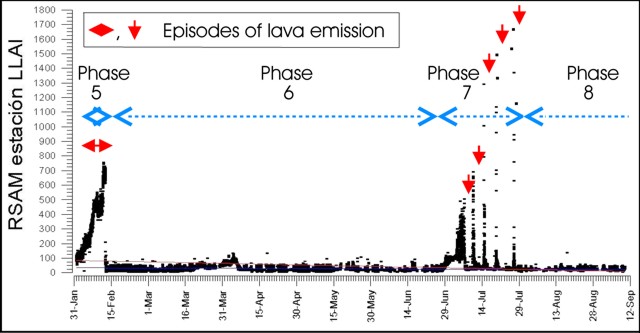Report on Llaima (Chile) — August 2008
Bulletin of the Global Volcanism Network, vol. 33, no. 8 (August 2008)
Managing Editor: Richard Wunderman.
Llaima (Chile) Eruption began 1 July 2008; summary of 2007-2008 eruptive cycle
Please cite this report as:
Global Volcanism Program, 2008. Report on Llaima (Chile) (Wunderman, R., ed.). Bulletin of the Global Volcanism Network, 33:8. Smithsonian Institution. https://doi.org/10.5479/si.GVP.BGVN200808-357110
Llaima
Chile
38.692°S, 71.729°W; summit elev. 3125 m
All times are local (unless otherwise noted)
Our previous report on Llaima (BGVN 33:06) described eruptions, tremor, and ash plumes between January-April 2008. This report discusses activity during June-September 2008, including a new eruption beginning 1 July. No reports of activity were received during May 2008.
During 1-20 June 2008, the Southern Andes Volcanological Observatory of the Chile National Service of Geology and Mining (OVDAS-SERNAGEOMIN) reported that sporadic gas-and-ash plumes were observed. More frequent and continuous gas emissions rose from the nested cone in the main crater, and steam plumes rose from the W flank toward the end of this time period.
During 13-16 June, seismicity increased. The National Bureau of Emergency of the Chile Ministry of Interior (ONEMI) reported that, during an overflight on 26 June, bluish gas and ash rose from the top of an active pyroclastic cone and the NE flank no longer was covered with snow.
July 2008 was characterized by several episodic seismic events, followed by periods of relative quiet. On 1 July, a lava flow on the W flank prompted authorities to evacuate about 20-30 people and warn others that additional evacuations might be necessary. The volcano alert level was raised to Yellow (the middle level on a 3-level color system). A lava flow, described as incandescent, descended 800-1000 m along the W flank of the crater, raising concern for lahars in the Calbuca River (figure 22).
During the first week of July, gas-and-ash plumes were emitted from the summit, and the main crater emitted vapor plumes and bluish gas. Fine ashfall was reported in areas nearby, and lahars were generated. On 2 July, an explosion from the summit ejected material to an altitude of 1 km which landed on the SW flank and up to 3.5 km away on the SE flank. OVDAS-SERNAGEOMIN observed incandescence from the 1-km-long lava flow on the W flank. An overflight revealed cooled blocks at the end of the lava flow and a second lava flow (on the SW flank) about 150 m S of the first. The lava flows issued from the base of a pyroclastic cone in the main crater. On 3 July, another overflight revealed that the lava flow on the W flank had advanced and generated a small lahar where lava melted ice on the volcano flanks (figure 23). On 4 July, OVDAS-SERNAGEOMIN characterized the eruptive style as weakly strombolian. A small explosion from the pyroclastic cone in the main crater produced an ash plume that rose 250-400 m and drifted 50 km SE. During 4-5 July, observers reported sporadic explosions and incandescence at the summit. On 6 July seismicity decreased to low levels.
By 7 July the lava emission rate had decreased. At that time, the lava flow on the W flank was about 1.6 km long and the flow on the SW flank was about 2 km long. A new eruptive phase occurred on 10 July (figure 24) when a vigorous Strombolian eruption ejected incandescent pyroclastic material from two vents in the main crater to heights of 500 m above the summit, throwing bombs to the E, NE, and S. Strong activity continued for almost three hours before decreasing. Medium to coarse ash (up to 1.5 mm in diameter) fell in Melipeuco, and lava flows moved toward the W and S flanks. Poor weather prevented observations during the next days.
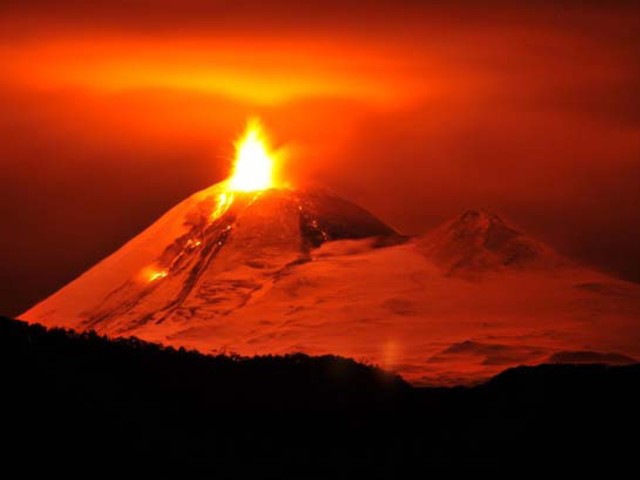 |
Figure 24. The eruptive phase of Llaima of 10 July 2008 as seen from El Manzano (SW). A strong explosion occurred 0555 hr, and three lava flows were observed. Courtesy of Victor Hazeldine. |
On 14 July another episode of increased seismicity accompanied an ash plume that rose to an altitude of 5.6 km. Very intense orange and red incandescence was seen near the summit and at the base of the W flank through breaks in the cloud cover. Later that day, a vigorous strombolian eruption ejected incandescent pyroclastic material from the N crater within the main crater to heights of 500 m above the summit. Seismicity and the intensity of the explosions decreased later that day. On 15 July, diffuse ash emissions rose to an altitude of 3.4 km. Ash and tephra covered areas of the SSE flank.
Seismicity decreased during 16-18 July 2008, but increased again on 19 July. Ash-and-gas plumes rose to an altitude of 3.3 km and drifted SE. The emissions became more intense and frequent. An explosion expelled one ash plume to an altitude of 4.1 km. Ash and tephra fell on the SE flank and in areas near the volcano, and constant explosions ejected incandescent material 500 m above the summit. Steam plumes and lava flows were also observed. Cloud cover prevented observations during 22-23 July.
Another eruptive episode occurred during 26-27 July for a period of 11.5 hours. During that time, Strombolian activity intensified and ejected material 500-800 m above the crater. Rhythmic explosions ejected spatter 1 km above the summit and up to 2 km E. Area residents heard "detonations" from the direction of the volcano. Observers noted gas-and-ash plumes, steam plumes, and a bluish gas emission. One plume rose to an altitude of 10 km. Lava flows emitted at a high rate descended the W and S flanks, producing steam plumes upon contact with ice. This activity prompted SERNAGEOMIN to raise the alert level to Red.
During 28 and 29 July, the volcano was calm, although fumarolic activity and sulfur dioxide plumes were observed. On 31 July, fumarolic activity from the crater was reported in multiple areas around the volcano. Scientists from OVDAS-SERNAGEOMIN observed fumarolic activity from the edges of the nested cones in Llaima's main crater during overflights on 29 July. Sulfur dioxide (SO2) plumes rose from an area in the E crater. Tephra deposits covered parts of the SE flank. Cooled lava flows emitted on 26 and 27 July were noted on the W flank. On 31 July, fumarolic activity from the crater was reported in multiple areas around the volcano. Cloudy conditions prevented visual observations during 1-2 August. On 2 August, as a result of decreased seismic activity, SERNAGEOMIN reduced the volcano alert level to Yellow.
OVDAS-SERNAGEOMIN reported during 8-11 August that fumarolic activity from the snow-free pyroclastic cones in Llaima's main crater was visible during periods of clear weather. Plumes drifted E. A 2-km-long strip on the NE flank was also black in color (snow-free) due to elevated temperatures. On 13 August, gas-and-ash plumes rose to an altitude of 3.3 km and drifted E. Later that day, crater incandescence accompanied the ash emissions.
Steam plumes from the pyroclastic cones in Llaima's main crater were visible during periods of clear weather on 16 August. Evaporation plumes rose from the W flank where lava flows were active in both February and July 2008. On 17 August, sporadic gas-and-ash emissions were observed. Cloud cover prevented observations during 18-20 August. On 21 August, three explosions produced ash plumes that rose to an altitude of 3.6 km and drifted E. Gas and steam was emitted between explosions, and resultant plumes rose to an altitude of 3.4 km and drifted 9 km E. During an overflight, scientists observed steam-and-gas plumes rising from a small crater in the N sector of the main crater. A larger crater, about 100 m in diameter, in the central sector emitted ash. The ash plumes rose to an altitude of 3.4 km and drifted E. A thin layer of ash blanketed the E flank. Ash-and-gas plumes from the main crater drifted W on 22 August. On 23 August, observers reported that incandescent material was ejected less than 1 km above the crater. The next day, an ash plume drifted about 1.5 km SSE. Ash blanketed some areas of the flanks.
Explosions were heard during 25-28 August. On 28 August, seismometer records indicated that gas-and-ash plumes were possibly emitted from the pyroclastic cones in the main crater. Clouds prevented visual observations of Llaima during 29 August-2 September. On 3 September, fumarolic plumes that originated from three points on the pyroclastic cones in the main crater were observed to drift N. An explosion produced an ash plume that also drifted N; ash deposits on the N flank suggested previous emissions. On 4 September gas plumes from the main crater drifted W. Gas-and-steam plumes were emitted during 5-7 September (figure 25).
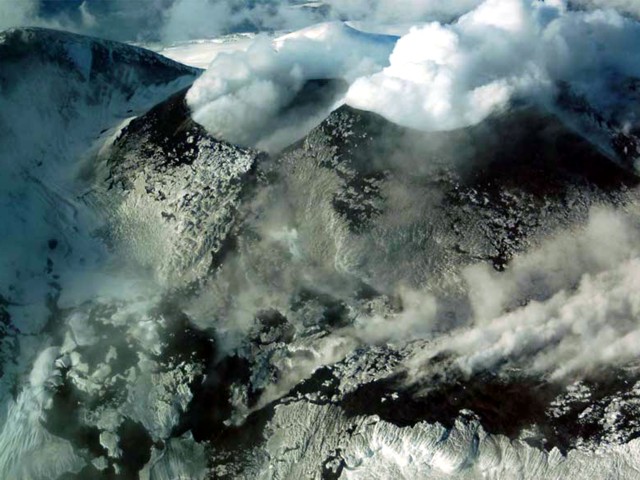 |
Figure 25. Gas emissions, mainly water vapor, rose from the craters at Llaima during 5-7 September 2008. Courtesy of OVDAS- SERNAGEOMIN. |
On 10 September 2008 the volcano alert level for Llaima was lowered to Green due to decreased seismicity and no major emissions. During an overflight on 12 September, OVDAS-SERNAGEOMIN scientists observed diffuse gas-and-steam plumes emitted from the external edges of the nested craters in the main crater (figure 26). During 13-22 September, observers in Melipeuco (about 17 km SSE) reported sporadic gas-and-steam plumes coming from the main crater. During an overflight on 21 September, steam emissions were noted from the NE and W flanks.
Thermal Anomalies. Thermal anomalies at Llaima were measured by satellite-based MODIS/MODVOLC instruments and algorithm (table 4). Anomalies were not observed during the 10 July or 14 July seismic events, perhaps because of poor weather conditions.
Table 4. Thermal anomalies measured at Llaima during July 2008. No anomalies were measured by the MODIS/MODVOLC satellite thermal alert system during June 2008 or from 28 July-1 October 2008. This table is a continuation of the tables from BGVN 33:01 and 33:06. Courtesy of HIGP Thermal Alerts System.
| Date | Time (UTC) | Pixels | Satellite |
| 01 Jul 2008 | 0625 | 1 | Aqua |
| 02 Jul 2008 | 0355 | 3 | Terra |
| 02 Jul 2008 | 0530 | 2 | Aqua |
| 02 Jul 2008 | 1455 | 2 | Terra |
| 03 Jul 2008 | 0435 | 3 | Terra |
| 03 Jul 2008 | 0615 | 3 | Aqua |
| 03 Jul 2008 | 1540 | 2 | Terra |
| 03 Jul 2008 | 1815 | 1 | Aqua |
| 04 Jul 2008 | 0340 | 2 | Terra |
| 19 Jul 2008 | 1815 | 1 | Aqua |
| 27 Jul 2008 | 0345 | 3 | Terra |
Summary of 2007-08 eruptive cycle. In September 2008, OVDAS-SERNAGEOMIN issued a synthesis of the 2007-08 eruptive cycle. The cycle, beginning 26 May 2007, consisted of eight eruptive phases (table 5). Seismic energy was high in phases 5 and 7, but low in phases 6 and 8 (figure 27). Seismic pulses in phase 7 (figure 28) corresponded with lava emissions.
Table 5. Llaima eruptive phases 1-8 and their date ranges as defined by OVDAS-SERNAGEOMIN. The table highly compresses the phases previously described in the Bulletin and presents more details for the phases 7 and 8. Courtesy of OVDAS-SERNAGEOMIN.
| Date Range | Eruptive Phase | Summary of Activity |
| 26 May 2007-31 Dec 2007 | Phase 1 | Characterized by the start of seismic and visual anomalies (BGVN 33:01). |
| 01 Jan 2008-02 Jan 2008 | Phase 2 | Began with a sudden strombolian eruption in the main crater and events that culminated after ~12 hours of intense activity (BGVN 33:01 and 33:06). |
| 02 Jan 2008-21 Jan 2008 | Phase 3 | Consisted of explosions, ash emissions and pyroclastic flows (BGVN 33:01 and 33:06). |
| 21 Jan 2008-02 Feb 2008 | Phase 4 | Included moderate reactivation of the strombolian phase with formation of a small lava lake in the main crater, growth of the internal cone, and formation of several eruptive centers (BGVN 33:01 and 33:06). |
| 02 Feb 2008-13 Feb 2008 | Phase 5 | Characterized by a calm lava emission and some small explosions within the internal pyroclastic cone (BGVN 33:01 and 33:06). |
| 13 Feb 2008-01 Jul 2008 | Phase 6 | Saw noticeable change in the activity of the volcano, characterized by the lack of significant seismic activity and emissions (BGVN 33:06). |
| 01 Jul 2008-27 Jul 2008 | Phase 7 | Included the following five eruptive episodes (figure 28) with brief periods of calm (weak emissions of ash and/or gases): 1) 1-7 July, emissions and small lahars, 2) 10 July, strombolian eruption and lava emission, 3) 14 July, strombolian eruption and lava emission, 4) 19 July, strombolian eruption and lava emission, and 5) 26 July, a vigorous strombolian eruption with a high rate of lava emission. |
| 27 Jul 2008-10 Sep 2008 | Phase 8 | Characterized by sporadic weak ash ejection, pyroclastic cones nested in the main crater continued to give off weak gas emissions. Seismic energy levels as of August 2008 remained low. |
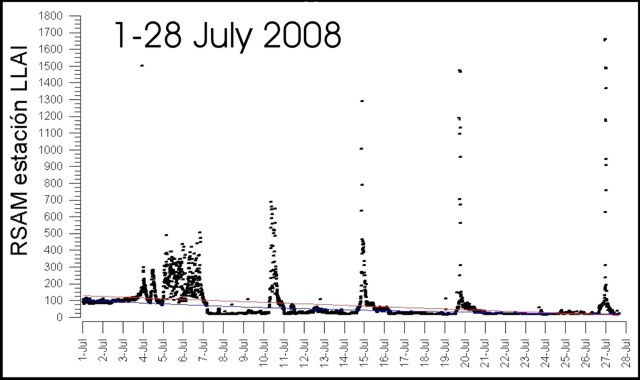 |
Figure 28. Summary of the released seismic energy in units of RSAM during the five eruptive episodes of Phase 7 of Llaima in July 2008. Courtesy of OVDAS-SERNAGEOMIN. |
Reference. Ewert, J.W., Murray, T.L., Lockhart, A.B., and Miller, C.D., 1993, Preventing Volcanic Catastrophe: The U.S. International Volcano Disaster Assistance Program: Earthquakes and Volcanoes, v. 24, no.6.
Geological Summary. Llaima, one of Chile's largest and most active volcanoes, contains two main historically active craters, one at the summit and the other, Pichillaima, to the SE. The massive, dominantly basaltic-to-andesitic, stratovolcano has a volume of 400 km3. A Holocene edifice built primarily of accumulated lava flows was constructed over an 8-km-wide caldera that formed about 13,200 years ago, following the eruption of the 24 km3 Curacautín Ignimbrite. More than 40 scoria cones dot the volcano's flanks. Following the end of an explosive stage about 7200 years ago, construction of the present edifice began, characterized by Strombolian, Hawaiian, and infrequent subplinian eruptions. Frequent moderate explosive eruptions with occasional lava flows have been recorded since the 17th century.
Information Contacts: OVDAS-SERNAGEOMIN (Observatorio Volcanológico de los Andes del Sur-Servico Nacional de Geologia y Mineria; Southern Andes Volcanological Observatory-National Geology and Mining Service), Avda Sta María No. 0104, Santiago, Chile (URL: http://www.sernageomin.cl/); NASA Earth Observatory (URL: http://earthobservatory.nasa.gov/); Hawai'i Institute of Geophysics and Planetology (HIGP) Thermal Alerts System, School of Ocean and Earth Science and Technology (SOEST), Univ. of Hawai'i, 2525 Correa Road, Honolulu, HI 96822, USA (URL: http://modis.higp.hawaii.edu/); Oficina Nacional de Emergencia (ONEMI), Ministerio del Interior, Chile (URL: http://www.onemi.cl/).


